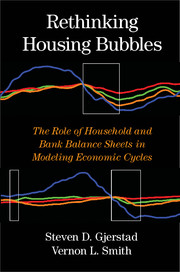 Rethinking Housing Bubbles
Rethinking Housing Bubbles Book contents
- Frontmatter
- Contents
- Acknowledgments
- 1 Economic Crises, Economic Policy, and Economic Analysis
- 2 Goods and Services Markets versus Asset Markets
- 3 Asset Performance
- 4 The Great Depression
- 5 The Postwar Recessions
- 6 What May Have Triggered or Sustained the Housing Bubble (1997–2006)?
- 7 The Bubble Bursts
- 8 Blindsided Experts
- 9 What Might Be Done?
- 10 Learning from Foreign Economic Crises
- 11 Summary: What Have We Learned?
- Index
- References
2 - Goods and Services Markets versus Asset Markets
Published online by Cambridge University Press: 05 June 2014
- Frontmatter
- Contents
- Acknowledgments
- 1 Economic Crises, Economic Policy, and Economic Analysis
- 2 Goods and Services Markets versus Asset Markets
- 3 Asset Performance
- 4 The Great Depression
- 5 The Postwar Recessions
- 6 What May Have Triggered or Sustained the Housing Bubble (1997–2006)?
- 7 The Bubble Bursts
- 8 Blindsided Experts
- 9 What Might Be Done?
- 10 Learning from Foreign Economic Crises
- 11 Summary: What Have We Learned?
- Index
- References
Summary
Cassano agreed to meet with all the big Wall Street firms and discuss the logic of their deals – to investigate how a bunch of shaky loans could be transformed into AAA-rated bonds. Together with [Eugene] Park and a few others, Cassano set out on a series of meetings with Morgan Stanley, Goldman Sachs, and the rest – all of whom argued how unlikely it was for housing prices to fall all at once. “They all said the same thing,” says one of the traders present. “They’d go back to historical real-estate prices over 60 years and say they had never fallen all at once.”
– Michael Lewis, Vanity Fair, July 2009It’s a pretty unlikely possibility. We’ve never had a decline in house prices on a nationwide basis. So, what I think is more likely is that house prices will slow, maybe stabilize, might slow consumption spending a bit. I don’t think it’s gonna drive the economy too far from its full employment path, though…
– Ben Bernanke, CNBC Interview, July 1, 2005Two Types of Markets: The Good and the Sometimes Ugly
This chapter summarizes findings from two distinct types of experimental markets that are directly relevant to understanding the sources of both stability and instability in the macroeconomy: (1) the class of nondurable consumed goods and services that constitute about 75 percent of U.S. private expenditures (i.e., GDP minus government expenditures); and (2) asset markets, particularly those in which the items traded have long lives and whose market value, therefore, may be importantly influenced by the future price expectations of the participants (prominent examples include houses, securities, and commercial real estate). The parallels between the laboratory and the economy in each of these two cases suggest underlying modes and principles of human behavior that are similar – conditional on the differing characteristics of the items being traded in these two broad categories of economic activity.
- Type
- Chapter
- Information
- Rethinking Housing BubblesThe Role of Household and Bank Balance Sheets in Modeling Economic Cycles, pp. 20 - 48Publisher: Cambridge University PressPrint publication year: 2014


